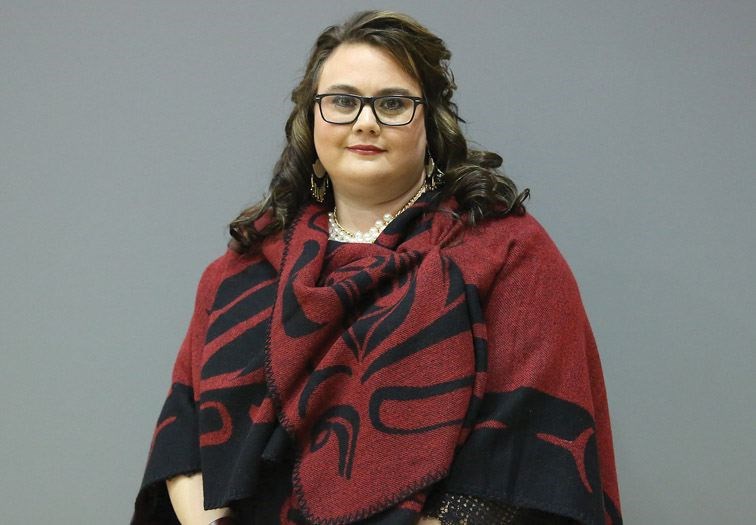Aboriginal students are finally seeing themselves represented in School District 57 and that's translating to better graduation rates, says its aboriginal education manager.
"Our kids are starting to feel that they belong as part of the education system and that they do have value and that they do have an opportunity to be very successful," said Shelly Niemi.
Niemi and her department are fresh off the largest aboriginal education conference Prince George has hosted, where Niemi told the crowd of more than 700 that the district had handed out the highest number of Dogwood Diplomas in its history.
In 2015, 60.5 per cent of aboriginal students graduated, up from the 48 per cent who graduated in 2014, representing some of the worst rates in the province that year.
"I don't expect us to see a 13 per cent jump next year," said Niemi, adding 2014 was a bit of an anomaly. The year before 56 per cent of students graduated, and the year before that, it was 55 per cent.
But still, Niemi said staff are encouraged by the incremental increases.
And what's good for Prince George is also good for the province, since the local district teaches the most aboriginal student learners in B.C., with 3,380 self-identified aboriginal students, accounting for 28 per cent of its student population. Last year, the district was just behind the provincial average for aboriginal student graduation at 63 per cent.
But, those numbers are still far behind non aboriginal rates, at 86 per cent. In Prince George, the non-aboriginal graduation rate was 79 per cent.
"There's still a 20 per cent gap between our children," Niemi said. "I think over the next five years what we're going to see is the narrowing of that gap."
The Ministry of Education said improving outcomes for aboriginal students is one of its highest priorities.
"It's great to see the improvements in the six year completion rates for Aboriginal students in Prince George," said an emailed Ministry statement. Minister Mike Bernier was not available for an interview.
On several occasions Ministry staff has recently met with district staff "to help them analyze student data, and with identifying where and when students need additional supports," the statement continued.
"Every year we're trying to refine a little bit deeper, the programs we offer, the professional development," Niemi said.
That work includes hiring aboriginal education workers for each and every school - the department now employs more than 100 workers, which is unique to departments, Niemi said.
"The one thing that makes me most proud is that we actually put people, site-based, in buildings and they're not itinerant. And because of that it allows a person to be connected to a building, that can build relationships."
It also includes visual reminders and aboriginal teaching methods - like Prince George secondary school's new outdoor learning centre or the moosehide mural at Duchess Park secondary. Or, the work of the department's two new sports coordinators who work with both aboriginal and non-aboriginal students, knowing student outcomes improve when they are invested in physical education.
Then there's the transition worker program, where staff go into the community and try to bring students back into the fold if they aren't coming to school.
"I think that contributed to our increased grad rates," she said.
This year B.C. launched a new curriculum that emphasizes "relevant, authentic inclusion of content regarding aboriginal culture, language and history," according to the Ministry's website.
"We are ensuring the history and ongoing legacy of the residential school system is taught, particularly when learning about topics such as discrimination, inequality, oppression, and impacts of colonialism."
This spring the district will sign its very first Aboriginal Education Enhancement Agreement, which in most cases "have had improved completion rates, academic achievement, and cultural awareness," the Ministry said.
It is one of the last districts in the province to sign such an agreement, which bring the local First Nations, school district and the province together to collectively set goals around improving aboriginal student success and learning experiences.
"We're moving in the right direction," said Niemi. "It's not a negative thing that we're so far behind. I think it just wasn't the right time or the right leadership from all different angles within our system."
The Ministry said it played "a key role" in shaping and facilitating that process, which led to a draft document prepared in the fall.
The district's aboriginal department is also nearing the end of a two-year research project designed to analyze what it could do better and what worked for aboriginal students.
"The biggest thing it affirmed is some things we already knew. Our children want to feel safe when they come to school, safe meaning that our system is aware that racism and stereotyping still exists," she said, and creating that cultural awareness training and support. "Also so the students can start to see their culture as part of the education system."
Like Niemi, the Ministry echoed the sentiment that there is "more to do" but said efforts in recent years has led to more aboriginal students staying in school than ever before.
"When we see that we hit the highest that we've ever hit I think we were number one really proud of our district because we've come so far in aboriginal education and the work we're doing collaboratively as a system over the last five years," Niemi said.
It shows that there's district-wide ownership of aboriginal education, she said.
"Now we are becoming a seamless system that everybody's focusing on how to improve better experiences for First Nations families and aboriginal students."



